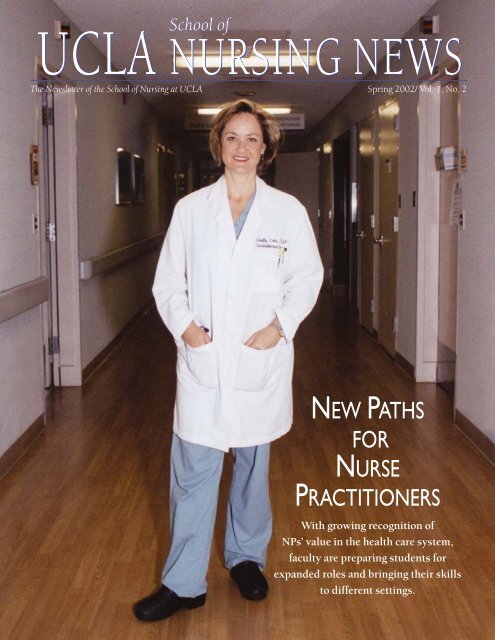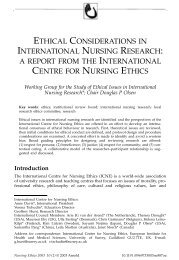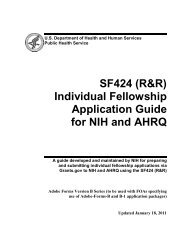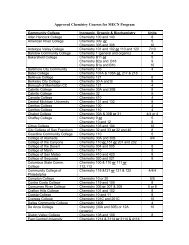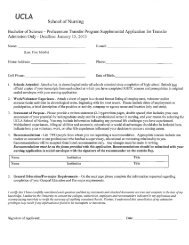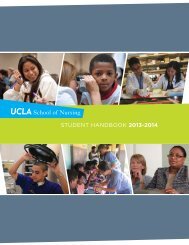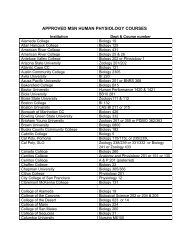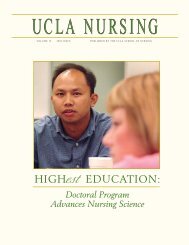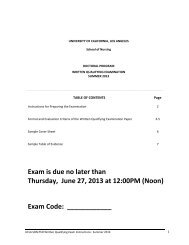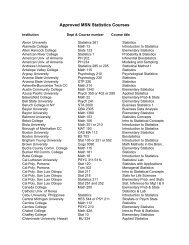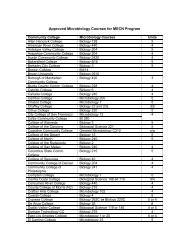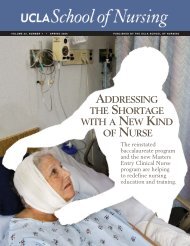Spring 2002 - UCLA School of Nursing
Spring 2002 - UCLA School of Nursing
Spring 2002 - UCLA School of Nursing
You also want an ePaper? Increase the reach of your titles
YUMPU automatically turns print PDFs into web optimized ePapers that Google loves.
WEB-BASED DIAGNOSTIC PROGRAMENHANCES CLINICAL LEARNINGFranco Dombkoski, a 71-year-oldman, has come to the clinic complaining<strong>of</strong> shortness <strong>of</strong> breath. The<strong>UCLA</strong> <strong>School</strong> <strong>of</strong> <strong>Nursing</strong> student who seesDombkoski under the watchful eyes <strong>of</strong> apreceptor is being put to the test, with theopportunity to take a history, conduct aphysical exam and order labtests where necessary. Thestudent will receive feedbackfrom the preceptor for howthorough and efficient he orshe is in the encounter.It sounds like thesame process advancedpracticenursing studentshave gone throughfor years in their clinicaltraining. But this is different.Mr. Dombkoskiisn’t a flesh-and-bloodpatient, but a case presentedas part <strong>of</strong> a Webbasedinstructional computers<strong>of</strong>tware programcalled DxR Clinician,which enables students,from the comfort <strong>of</strong> their home computer,to learn about clinical decision-making anddiagnosis in a way that simulates the clinicalenvironment to the extent that lecturesand textbooks can’t.“Nothing is going to replace workingwith actual patients and an actual preceptor,”says Dr. Colleen Keenan, associatepr<strong>of</strong>essor at the <strong>UCLA</strong> <strong>School</strong> <strong>of</strong> <strong>Nursing</strong>,who is leading the effort with Dr. LynnDoering. “But our clinical faculty are parttime,and with changes resulting from managedcare, our preceptors are very busy.They can’t take all the time it takes to doclinical teaching with beginning students.”So the school has purchased DxR DevelopmentGroup’s s<strong>of</strong>tware and, beginninglast fall, integrated it into the courseworkfor all clinical graduate students. The DxRClinician program, which was designed toteach both medical and nurse practitionerstudents, simulates real cases such as Mr.Dombkoski’s. In “interviewing” patients,students can choose from more than 250questions in 20 categories, ranging frompresent illness to questions about the patient’shistory. Eighteen exam tools that produce morethan 425 physical and neurological exams areavailable, presenting real heart and breath“A lot <strong>of</strong>instructionalapproachesdon’t reflectclinical realities.This will helpour studentsbe even betterprepared tostart seeingpatients.”Dr. Colleen Keenansounds with each case and, in some cases, digitalvideo presentations. Thirty-two common labswith more than 400 other labs and proceduresare available for each case, including X-rays,magnetic resonance imaging, nuclear imaging,and electrocardiograms. (Sample cases can befound at DxR Development Group’s Web site,www.dxrgroup.com.)All along, students report theirhypotheses and interpretations asthey collect data that lead to a finaldiagnosis. Later, the instructor candownload the student’s work andtrace the clinical decision-makingprocess, providing evaluation andfeedback on how it might be improved.DxR Clinician is the latest andmost extensive adoption by theschool <strong>of</strong> the teaching methodologyknown as problem-basedlearning, which has gained favoramong clinical educators. “A lot <strong>of</strong>instructional approaches don’t reflectclinical realities,” Keenan says.“When students see a real patient,the patient comes forward with asymptom and a set <strong>of</strong> complaints, and it’s up tothe student to ask the appropriate questions andselect the appropriate diagnostic tests in order toreach the correct diagnosis. That’s very differentfrom the way things are presented in textbooks,where the diagnosis is already assumed and thenyou backtrack and learn about how you gotthere.”In addition to giving students a more realisticexperience than would be possible in a lecture ortextbook, the program <strong>of</strong>fers the additional advantage<strong>of</strong> being accessible to students any timeand anywhere as long as they have a computerwith an Internet connection. “Students canspend as much time as they want on the case,and it’s very convenient to be able to do it athome,” Keenan says.Keenan points out that the school is still evaluatingthe program’s impact on the curriculum,but so far the signs are positive. “Our students alreadyhad an excellent reputation among ourpreceptors,” she says, “but this will help them tobe even better prepared to start seeing patientswhen they walk into the clinical sites.”
UPDATE:CENTER FORVULNERABLEPOPULATIONS RESEARCH AT <strong>UCLA</strong>The Center for Vulnerable Populations Research(CVPR) was established at the<strong>UCLA</strong> <strong>School</strong> <strong>of</strong> <strong>Nursing</strong> in 1999 with a$1.48 million National Institute <strong>of</strong> <strong>Nursing</strong>Research grant award. The center, directed byDr. Deborah Koniak-Griffin and co-directed byDr. Adeline Nyamathi, brings together faculty atthe school, from other parts <strong>of</strong> the <strong>UCLA</strong> campusand from the community, with the goal <strong>of</strong> improvingthe health <strong>of</strong> social groups that are atincreased risk for health problems. Partnershipsare established with communities through mutualdefinitions <strong>of</strong> needs and the identification<strong>of</strong> strengths and resources. Based on this assessment,interdisciplinary scientists, research participants,and community collaborators developand implement research to eliminate health disparities.Study results are then disseminatedwithin the communities <strong>of</strong> research participants,scholars, ethicists, and policy-makers.Three years after its establishment, the centeris thriving, with regular presentations and anumber <strong>of</strong> ongoing studies and community projects,including:Lay Health Advisors and Health EducationObesity, lack <strong>of</strong> physical exercise, and exposureto tobacco smoke – health problems that contributeto chronic disease and decreased life expectancy– are on the rise in Southern California,and affect some community groups more thanothers. Particularly vulnerable are those groupswith limited resources to deal with these problems.A joint project by the CVPR, the Los AngelesCounty Department <strong>of</strong> Health Services, andthe local community seeks to address this concernwith an educational community outreachproject conducted by lay health advisors, whopromote health in the areas <strong>of</strong> nutrition, physicalexercise, and smoke-free living environments.Lay health advisor outreach programs <strong>of</strong>fer aresource to communities with unmet needs, andhave been shown to be successful.HIV Vaccine TrialsMore than a dozen HIV vaccine products are beingtested in clinical trials in the United Statesand the developing world. But little is known <strong>of</strong>the challenges that will confront researchers interestedin assessing the efficiency and efficacy <strong>of</strong>future clinical trials in individuals targeted forthe large-scale trials – racial and ethnic minorities,the impoverished, and substance-usingpopulations. These groups have been historicallymarginalized and disenfranchised, and maintaina high level <strong>of</strong> distrust <strong>of</strong> the federal governmentand public health research. Thus, Nyamathi andKoniak-Griffin have received funding from the<strong>UCLA</strong> AIDS Institute to conduct a series <strong>of</strong> “thinktanks” to stimulate research and collaborative endeavorsto advance knowledge and skills inpreparing for these challenges.Boron in ChinaAs detailed in the last issue <strong>of</strong> <strong>UCLA</strong> <strong>School</strong> <strong>of</strong><strong>Nursing</strong> News, Dr. Wendie Robbins, with colleaguesin China and the United States, is implementinga study <strong>of</strong> the relationship betweenworkplace exposure to boron-containing compoundsand adverse male reproductive effects.Exposures <strong>of</strong> workers and persons living in communitiesnear the boron mines and processingplants in certain areas <strong>of</strong> northeast China were <strong>of</strong>concern to local environmental <strong>of</strong>ficials and thesurrounding communities. This fostered a collaborativeresearch relationship between the U.S.and China researchers.Latino Health Demonstration ProjectThis proposed project, a community partnershipbetween the CVPR and the Venice Family Clinic,is based on a request from nurses at the clinicwho designed and implemented a unique programin diabetes education. The study tests theeffects <strong>of</strong> this bilingual, bicultural communitybaseddiabetes education program through medicalrecords review, interviews with patients andproviders, and participant observation. Members<strong>of</strong> randomized and control groups are monitoredfor measures such as HbA1c, weight, blood pressure,and diabetes knowledge at the beginning <strong>of</strong>the program and four months into it. This is aparticularly important issue for the Venice FamilyClinic given that diabetes disproportionately affectsMexican Americans, who represent a largeportion <strong>of</strong> the clinic’s population.Lay health advisors (promotoras de salud)exercise as part <strong>of</strong> the health promotiontraining sessions run by the Center for VulnerablePopulations Research and Los AngelesCounty Department <strong>of</strong> Health Services.CENTER FOR VULNERABLEPOPULATIONS RESEARCHCONTINUING PILOT STUDIESJANNA LESSER,R.N.,Ph.D.“Perceptions <strong>of</strong> HIV Risk and ViolenceRisk Among Young Parents Living in orAround Housing Projects”MARY WOO,R.N.,D.N.Sc.“Cystic Fibrosis Education for HispanicPatients”NEW STUDIESJANET MENTES,R.N.,Ph.D.“Characterizing Pain in CognitivelyImpaired <strong>Nursing</strong> Home Residents”DOROTHY WILEY,R.N.,Ph.D.“Anal Cancer Screening:Knowledge,Attitudes, Beliefs”JILL BERG,R.N.,Ph.D.“Latino Families and AsthmaManagement:An Exploratory Study”
<strong>School</strong> Bids Farewell to Renowned Faculty Flaskerud, AndersonDrs. Jacquelyn Flaskerud (left) andNancy Anderson (right), two outstandingand popular faculty members,have retired from the <strong>UCLA</strong><strong>School</strong> <strong>of</strong> <strong>Nursing</strong>.Flaskerud began her nursingcareer in 1962 as the graduate <strong>of</strong>a diploma program. She went on to obtain a bachelor’s in nursing andthen a master’s in community mental health nursing.And, at a timewhen there were few Ph.D. nursing programs in the nation, she was thefirst graduate <strong>of</strong> the University <strong>of</strong> Illinois College <strong>of</strong> <strong>Nursing</strong> to finish adissertation and receive a Ph.D., with a minor in anthropology.Throughout her 40-year career in nursing, Flaskerud’s research focushas been on the relationship between culture and various illnesses indifferent ethnic groups. In the early 1980s, with encouragement fromDr. John Fahey, director <strong>of</strong> the Center for Interdisciplinary Research inImmunology and Diseases at <strong>UCLA</strong>, Flaskerud began AIDS researchwith a focus on ethnically diverse low-income women.In 1994, Flaskerud received a grant to train pre- and postdoctoralscholars in research on the health-related problems <strong>of</strong> vulnerable populations.Work with these scholars and interested faculty led her to developand publish a conceptual model for vulnerable populations researchin 1998.This model is used for the school’s Center for VulnerablePopulations Research, in which Flaskerud continues to play a vital role asa participatory researcher.Flaskerud is proud <strong>of</strong> the numerous pr<strong>of</strong>essional nursing organizationsand university committees on which she has served during hercareer, particularly those dedicated to ethnic diversity and equal opportunity.She has taught theory development in nursing at <strong>UCLA</strong> since 1987,and developed the Neuropsychiatric Nurse Practitioner Program,established at the school in 1996.The author <strong>of</strong> many articles, Flaskerudalso wrote an AIDS textbook for nurses that has generated four differenteditions with translations in French, Portuguese and Japanese.Anderson was inspired to go into nursing by her father, “a wonderfulnurse.” She found a way to combine a career in nursing with her childhoodpassion <strong>of</strong> anthropology and her fascination with other cultures.Like Flaskerud,Anderson began as a “diploma nurse,” graduating froma New York state program and going on to work at a Boston hospital.In 1973 she became a <strong>UCLA</strong> student, receiving a master’s degree in1975 and becoming a lecturer at the school.Anderson went on to obtaina doctoral degree in anthropology from <strong>UCLA</strong> in 1987. In 1989, shebegan her second tenure at <strong>UCLA</strong>, combining teaching, research andclinical practice as a member <strong>of</strong> the school’s full-time faculty.Although she has enjoyed all facets <strong>of</strong> her career,Anderson says thatteaching has been the most rewarding.“A teacher, like her students, is alwayslearning,” she says. She feels fortunate to have been able to watchher students’ careers develop,and has stayed in touch with many <strong>of</strong> them.Anderson’s interest is in the partnership between nurse/researcher and patient/research participant, and the role <strong>of</strong> cultural competenceand sensitivity.As a master’s student, she created a nursingmodel that was adapted for use in the undergraduate program as well asin participatory research as a qualitative method <strong>of</strong> collecting data. Much<strong>of</strong> Anderson’s research has focused on adolescents in community-basedand juvenile detention settings, particularly their risk-taking behaviors.Working with the Venice Family Clinic,Anderson is co-director withFlaskerud <strong>of</strong> the Social Policy and Dissemination Core <strong>of</strong> the Center forVulnerable Populations Research. Even though “<strong>of</strong>ficially” retired, bothwill continue to consult for the center.Please send any changes <strong>of</strong> address, as well as pr<strong>of</strong>essional or personal updates for use in future issues, to: Editor, <strong>UCLA</strong> <strong>School</strong> <strong>of</strong> <strong>Nursing</strong> News,Box 951702, Los Angeles, CA 90095-1702.You may also fax to (310) 206-7433, or e-mail to lapointe@support.ucla.edu.<strong>UCLA</strong> <strong>School</strong> <strong>of</strong> <strong>Nursing</strong>Box 951702Los Angeles, California 90095-1702Nonpr<strong>of</strong>it Org.U.S. Postage Paid<strong>UCLA</strong>Address Service RequestedNU17


